- FlexReport for WinForms Overview
- Key Features
- FlexReport versus other Reporting Controls
- Core Classes
- Design-Time Support
- Quick Start
- FlexReport Designer
- FlexReportDesigner Control
- Data Binding
- Load Reports
- Create Reports
- Sections of FlexReport
- Fields and Custom Fields
- Modifying the Fields
- Parameters
- VBScripting with ExpressionEditor
- Filtering Data
- Grouping Data
- Sorting Data
- Customize Reports
- Styling the Reports
- Export Reports
- Preview and Print Reports
- Deployment
- FlexViewer
Quick Start
Learn how to create a simple report application using the WinForms FlexReport control. Follow the steps below to get started:
Create a Report Definition
You can create report definitions using the FlexReport Designer application (with zero code) as well as programmatically. The easiest way to create a report definition using the FlexReportDesigner app, which is a stand-alone application similar to the report designer in Microsoft Access and Crystal Reports.
type=note
Note: The C1FlexReportDesigner.exe for 64-bit platform and C1FlexReportDesigner32.4.exe for 32-bit platform are located at C:\Program Files (x86)\ComponentOne\Apps\v4.5.2 on your computer.
Using FlexReportDesigner
FlexReportDesigner provides the FlexReport Wizard, a report engine to create reports. With this wizard, you can choose a suitable data source, select fields, layouts and style etc.
To begin, complete the following steps:
Run the C1FlexReportDesigner.exe file.
Go to File menu in the menu bar and select the New command to create a new empty report definition file.
Click New Report dropdown from the Reports tab located on the extreme left of designer and select Report Wizard.
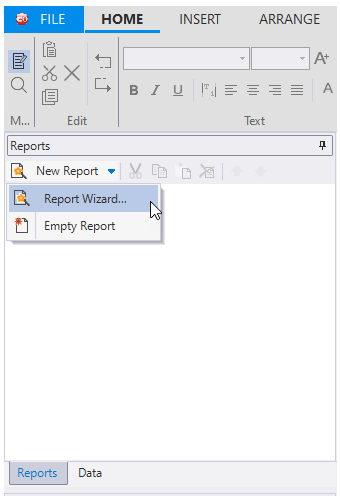
The FlexReport Wizard opens.
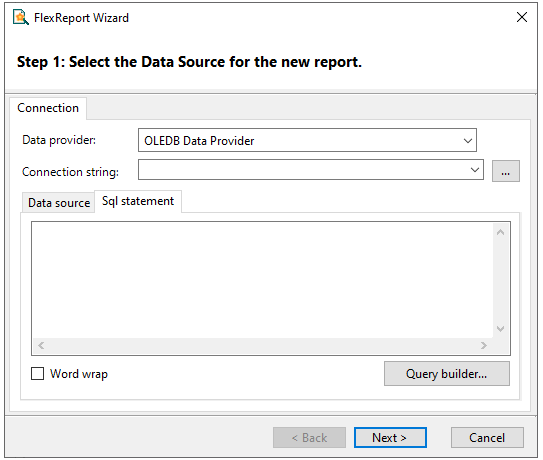
Here, we have used 'OLEDB Data Provider' as the data provider. You can also choose any other data provider from the drop-down button.
Add a DataSource to Report
Using the FlexReport Wizard, complete the following steps to add a data source in the new report:
Click the ellipsis button to bring up the standard connection string builder. The Data Link Properties dialog box opens.
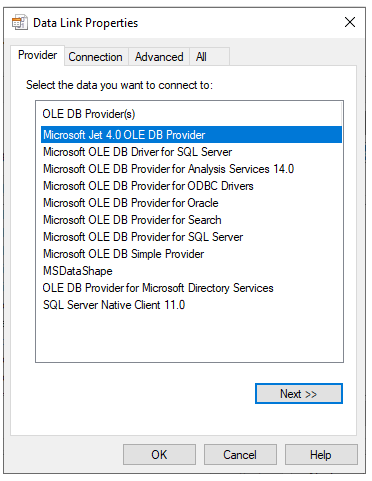
Select the Provider tab and select a data provider from the list. For this example, select Microsoft Jet 4.0 OLE DB Provider.
Click the Next button or select the Connection tab. Now, you must choose a data source.
Click the ellipsis button to select a database. The Select Access Database dialog box appears. For this example, select the C1NWind.mdb located in the Common folder in the ComponentOne Samples directory (by default installed in the Documents folder). Note that this directory reflects the default installation path and its path may be different if you made changes to the installation path.
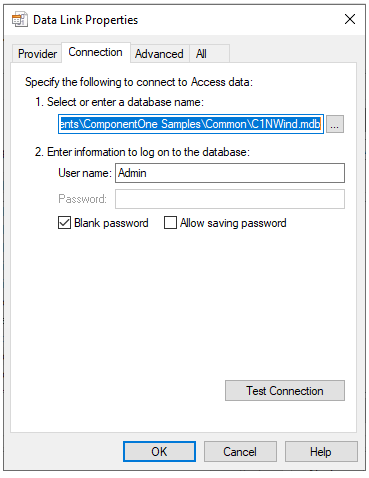
You can test the connection and click OK.
Click OK to close the Data Link Properties dialog box.
Once you have selected your data source, you can select a table, view, or stored procedure to provide the actual data.Click Next.
Select the Data source tab and select the Products table from the Tables list.
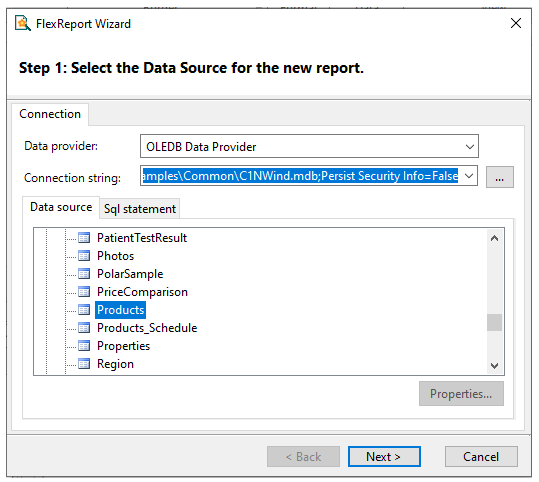
Select Data Fields
- Select the fields you want to include in the report using the FlexReport Wizard.
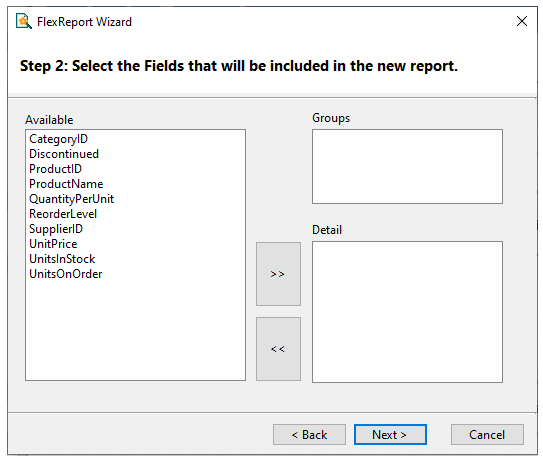 This page in the Wizard contains a list of fields available from the recordset you selected, and the two lists that define the group and detail fields for the report. Group fields define how the data will be sorted and summarized, and Detail fields define what information you want to appear in the report.
This page in the Wizard contains a list of fields available from the recordset you selected, and the two lists that define the group and detail fields for the report. Group fields define how the data will be sorted and summarized, and Detail fields define what information you want to appear in the report.
You can move fields from one list to another by dragging them with your mouse pointer. Drag fields into the Detail list to include them in the report, or drag within the list to change their order. Drag fields back into the Available list to remove them from the report. With your mouse pointer, select the CategoryID field and drag it into the Groups list. - Press the >> button to move the remaining fields into the Detail list.
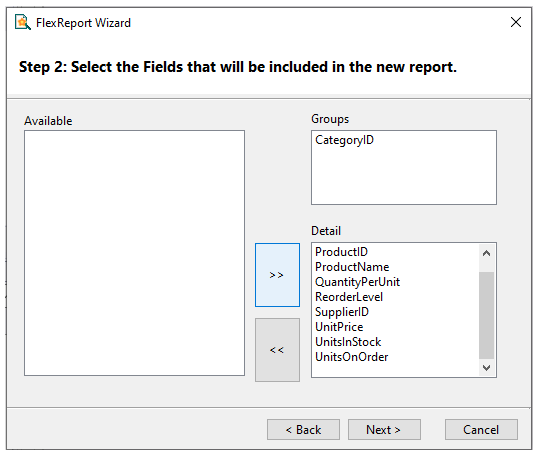 Click Next.
Click Next.
Select Layout and Style
Select the layout for the new report. FlexReport Wizard lets you select data layouts, page orientation and choose to adjust fields to fit the page. Keep the Outline layout.
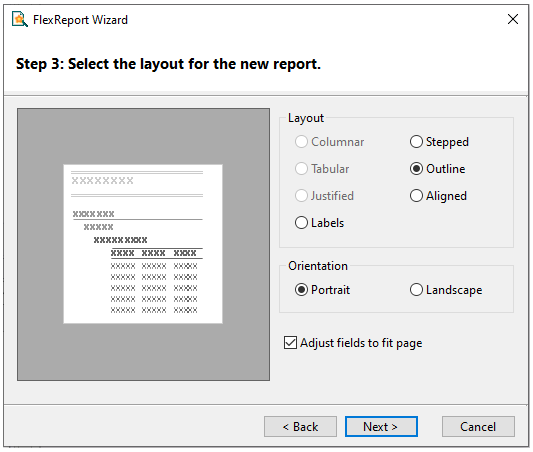
Click Next.
Select the style for the new report. The FlexReport Wizard lets you to select the fonts and colors that will be used in the new report.
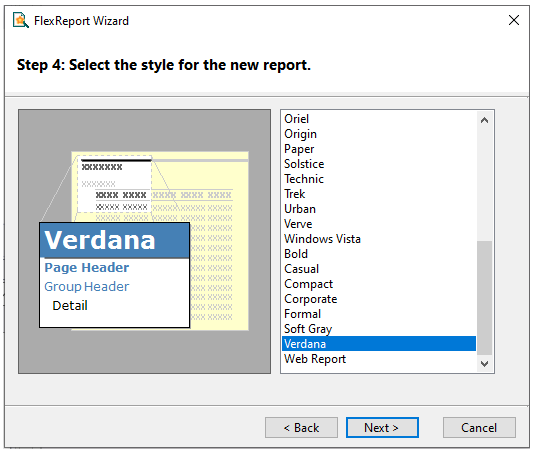
Click Next.
Add Title and Preview the Report
Select a title for the new report.
Enter a title for the new report, Products Report, for example.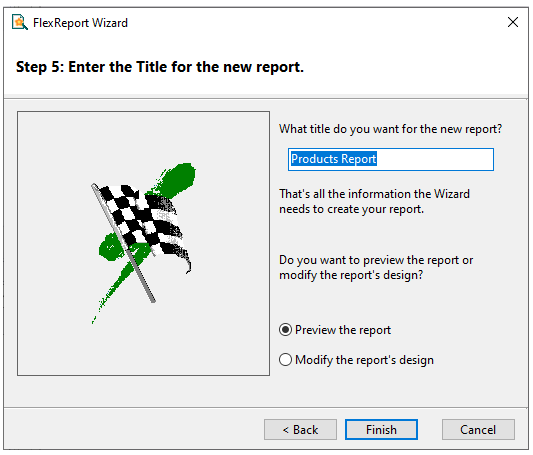
Choose Preview the report option and click Finish. You will immediately see the report in the preview pane of the Designer.
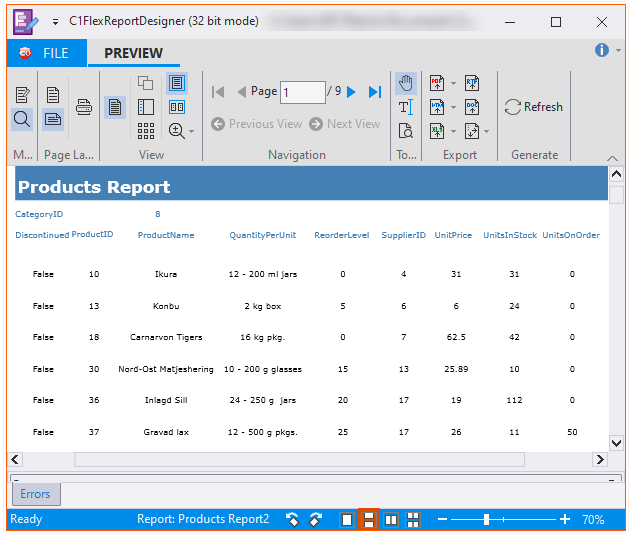
type=note
Note: You can invoke the FlexReportDesigner from Visual Studio as well. To do so, complete the following steps:
- Create a .NET project and add the FlexReport component to your Toolbox.
- From the Toolbox, double-click the FlexReport icon to add the component to your project. Note that the component will appear below the form in the Component Tray.
- Click the FlexReport component's smart tag and select Edit Report from its Tasks menu.
The FlexReportDesigner opens and the C1FlexReport Wizard is ready to guide you through the five easy steps discussed above.
Using Code
The following steps show how to create a simple tabular report definition based on the C1NWind database using code.
Add controls
First, add a button control, FlexReport component, and FlexViewer control to your form from the Toolbox. Set the following properties:
Control/Component Name Button btnEmployees FlexReport flexReport FlexViewer flexViewer Set up DataSource
Set up the DataSource object to retrieve the data from the C1NWind.mdb database. This is done using the ConnectionString and RecordSource properties:
// initialize DataSource DataSource ds = flexReport.DataSource; ds.ConnectionString = @"Provider=Microsoft.ACE.OLEDB.12.0;Data Source=C:\Users\GPCTAdmin\Documents\ComponentOne Samples\Common\C1NWind.mdb"; ds.RecordSource = "Employees";Call a utility function RenderEmployees() and add the code lines within the function as given below:
private void RenderEmployees() { flexReport.DataSource.RecordSourceType = RecordSourceType.Auto; // clear any existing fields // flexReport.Clear(); // set default font for all controls flexReport.Font.Name = "Tahoma"; flexReport.Font.Size = 8; }The code lines depict how to set a default font for the FlexReport component using the Font property. Further, the DataSource property in C1FlexReport class accesses the RecordSourceType enumeration to set the data source type. Setting the enumeration to Auto automatically determines the data source type based on the syntax used by the RecordSource property.
Add Layout
Next, initialize the Layout object that defines how the report will be laid out on the page. In this case, render the report in Portrait mode and set its Width to 6.5 inches (8.5 page width minus one inch for margins on either side):
//initialize Layout Layout l = flexReport.Layout; l.Orientation = OrientationEnum.Portrait; l.Width = 6.5 * 1440;Now comes the interesting part. Every report has five basic sections: Detail, Report Header, Report Footer, Page Header, and Page Footer. Use the following code to set up the report header by setting a couple of properties and adding a title field to it:
// create a report header Section s = flexReport.Sections[SectionTypeEnum.Header]; s.Height = 1440; s.Visible = true; s.BackColor = Color.FromArgb(200, 200, 200); TextField textFld1 = new TextField(); textFld1.Name = "FldTitle"; textFld1.Text = "Employees Report"; textFld1.Left = 0; textFld1.Top = 0; textFld1.Width = 8000; textFld1.Height = 1440; textFld1.Font.Size = 24; textFld1.Font.Bold = true; textFld1.ForeColor = Color.FromArgb(0, 0, 100); flexReport.Sections.Header.Fields.Add(textFld1);The section object has a Fields collection. The collection's Add method creates a new field and assigns it to the Section. The parameters specify the new field's Name, Text, Left, Top, Width, and Height properties. By default, the field has the same font as the control. Since this is a title, it makes sense to change the font and make it larger. Note that the field should be tall enough to accommodate the font size, or nothing will appear in it.
Add Page Footer
Next, set up the Page Footer Section. This section is more interesting because it contains expressions in the text fields. To evaluate the expressions in the text field, simply set the expression in the TextField.Text.Expression property. The expression in the text field is evaluated when the report is rendered. In C1Report, same is achieved by setting the field's Calculated property to True. To create a page footer, add the following code:
// create a page footer s = flexReport.Sections[SectionTypeEnum.PageFooter]; s.Height = 500; s.Visible = true; TextField textFld2 = new TextField(); textFld2.Name = "FldFtrLeft"; textFld2.Text.Expression = @"""Employees: Printed on "" & Now"; textFld2.Left = 0; textFld2.Top = 0; textFld2.Width = 4000; textFld2.Height = 300; textFld2.Font.Size = 8; textFld2.Font.Bold = false; flexReport.Sections.PageFooter.Fields.Add(textFld2); TextField textFld3 = new TextField(); textFld3.Name = "FldFtrRight"; textFld3.Text.Expression = @"""Page "" + Page + "" of "" & Pages"; textFld3.Left = 4000; textFld3.Top = 0; textFld3.Width = 4000; textFld3.Height = 300; textFld3.Align = FieldAlignEnum.RightTop; textFld3.Width = flexReport.Layout.Width - textFld3.Left; flexReport.Sections.PageFooter.Fields.Add(textFld3); //add a line before page footer ShapeField shpfld = new ShapeField(); shpfld.Name = "FldLine"; shpfld.ShapeType = ShapeType.Line; shpfld.Left = 0; shpfld.Top = 0; shpfld.Width = flexReport.Layout.Width; shpfld.Height = 20; flexReport.Sections.PageFooter.Fields.Add(shpfld);The Page Footer section uses expressions with variables that are not intrinsic to VBScript, but are defined by C1FlexReport.Page and Pages are variables that contain the current page number and the total page count. The section also uses a field configured to look like a line.
Add Page Header
Next, set up the Page Header Section. This section gets rendered at the top of every page and will display the field labels. Using a Page Header section to display field labels is a common technique in tabular reports. The code is simple, but looks a bit messy because of all the field measurements. In a real application, these values would not be hard-wired into the program. To create a page header with field labels, add the following code:
//create a page header with field labels s = flexReport.Sections[SectionTypeEnum.PageHeader]; s.Height = 500; s.Visible = true; flexReport.Font.Bold = true; TextField textFld4 = new TextField(); textFld4.Name = "LblID"; textFld4.Text = "ID"; textFld4.Left = 0; textFld4.Top = 50; textFld4.Width = 400; textFld4.Height = 300; textFld4.Align = FieldAlignEnum.RightTop; flexReport.Sections.PageHeader.Fields.Add(textFld4); TextField textFld5 = new TextField(); textFld5.Name = "LblFirstName"; textFld5.Text = "First"; textFld5.Left = 500; textFld5.Top = 50; textFld5.Width = 900; textFld5.Height = 300; flexReport.Sections.PageHeader.Fields.Add(textFld5); TextField textFld6 = new TextField(); textFld6.Name = "LblLastName"; textFld6.Text = "Last"; textFld6.Left = 1500; textFld6.Top = 50; textFld6.Width = 900; textFld6.Height = 300; flexReport.Sections.PageHeader.Fields.Add(textFld6); TextField textFld7 = new TextField(); textFld7.Name = "LblTitle"; textFld7.Text = "Title"; textFld7.Left = 2500; textFld7.Top = 50; textFld7.Width = 2400; textFld7.Height = 300; flexReport.Sections.PageHeader.Fields.Add(textFld7); TextField textFld8 = new TextField(); textFld8.Name = "LblTitle"; textFld8.Text = "Notes"; textFld8.Left = 5000; textFld8.Top = 50; textFld8.Width = 8000; textFld8.Height = 300; flexReport.Sections.PageHeader.Fields.Add(textFld8); flexReport.Font.Bold = false; ShapeField shpfld2 = new ShapeField(); shpfld2.Name = "FldLine"; shpfld2.ShapeType = ShapeType.Line; shpfld2.Left = 0; shpfld2.Top = 400; shpfld2.Width = flexReport.Layout.Width; shpfld2.Height = 20; flexReport.Sections.PageHeader.Fields.Add(shpfld2);This code illustrates a powerful technique for handling fonts. Since every field inherits the control font when it is created, set the control's Font.Bold property to True before creating the fields, and set it back to False afterwards. As a result, all controls in the Page Header section have a bold font.
Add Detail Section
To finalize the report, add the Detail Section. This is the section that shows the actual data. It contains expressions in the text fields below each label in the Page Header Section. To create the Detail section, add the following code:
// create the Detail section s = flexReport.Sections[SectionTypeEnum.Detail]; s.Height = 330; s.Visible = true; TextField textField = new TextField(); textField.Name = "FldID"; textField.Text.Expression = "EmployeeID"; textField.Left = 0; textField.Top = 0; textField.Width = 400; textField.Height = 300; flexReport.Sections.Detail.Fields.Add(textField); TextField textField1 = new TextField(); textField1.Name = "FldFirstName"; textField1.Text.Expression = "FirstName"; textField1.Left = 500; textField1.Top = 0; textField1.Width = 900; textField1.Height = 300; flexReport.Sections.Detail.Fields.Add(textField1); TextField textField2 = new TextField(); textField2.Name = "FldLastName"; textField2.Text.Expression = "LastName"; textField2.Left = 1500; textField2.Top = 0; textField2.Width = 900; textField2.Height = 300; flexReport.Sections.Detail.Fields.Add(textField2); TextField textField3 = new TextField(); textField3.Name = "FldTitle"; textField3.Text.Expression = "Title"; textField3.Left = 2500; textField3.Top = 0; textField3.Width = 2400; textField3.Height = 300; flexReport.Sections.Detail.Fields.Add(textField3); TextField textField4 = new TextField(); textField4.Name = "FldNotes"; textField4.Text.Expression = "Notes"; textField4.Left = 5000; textField4.Top = 0; textField4.Width = 8000; textField4.Height = 300; flexReport.Sections.Detail.Fields.Add(textField4); textField4.Width = flexReport.Layout.Width - textField4.Left; textField4.AutoHeight = AutoSizeBehavior.CanGrow; textField4.Font.Size = 6; textField4.Align = FieldAlignEnum.JustTop; //add a line after each field in detail section ShapeField shpfld3 = new ShapeField(); shpfld3.Name = "FldLine"; shpfld3.ShapeType = ShapeType.Line; shpfld3.Left = 0; shpfld3.Top = 310; shpfld3.Width = flexReport.Layout.Width; shpfld3.Height = 20; flexReport.Sections.Detail.Fields.Add(shpfld3);Note that all text fields contain expressions and each text field corresponds to the names of fields in the source record source. Setting the expressions in the TextField.Text.Expression property ensures that the Text property is interpreted as a database field name, as opposed to being rendered literally. It is important to adopt a naming convention for report fields that makes them unique, different from recordset field names. If you had two fields named "LastName", an expression such as "Left(LastName,1)" would be ambiguous. This example has adopted the convention of beginning all report field names with "Fld".
Note that the "FldNotes" field has its AutoHeight property set to CanGrow, and a smaller font than the others. This was done to make sure that the "Notes" field in the database, which contains a lot of text, will appear in the report. Rather than make the field very tall and waste space, setting the AutoHeight property to CanGrow tells the control to expand the field as needed to fit its contents; it also sets the containing section's AutoHeight property to True, so the field doesn't spill off the Section.
The report definition is done. To render the report into the FlexViewer control, double-click the Employees button to add an event handler for the btnEmployees_Click event. The Code Editor will open with the insertion point placed within the event handler. Enter the following code:
private void btnEmployees_Click(object sender, EventArgs e) { RenderEmployees(); flexViewer.DocumentSource = flexReport; }Here's what the basic report looks like:
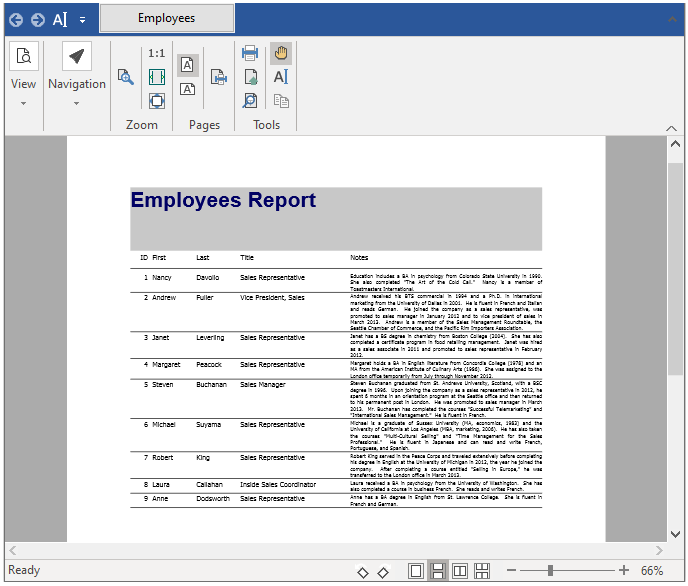
Modify the report
With the FlexReportDesigner in preview mode, you cannot make any adjustments to the report. Click the Design button to switch to Design mode and begin making modifications. The right pane of the main window switches from Preview mode to Design mode, and it shows the controls and fields that make up the report.
For this example, we will resize the Group Header section and fields as well as format a field value. To do this, complete the following steps:
To resize the Group Header section, select its border and with your mouse pointer drag to the position where you want it.
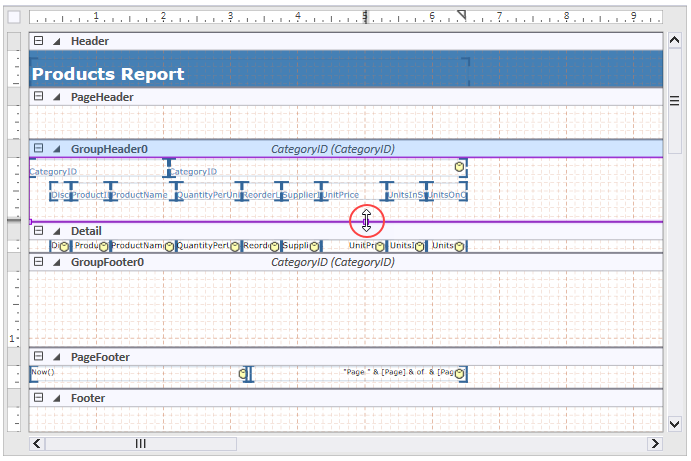
With your mouse pointer, drag the handles in the field corners to resize fields.
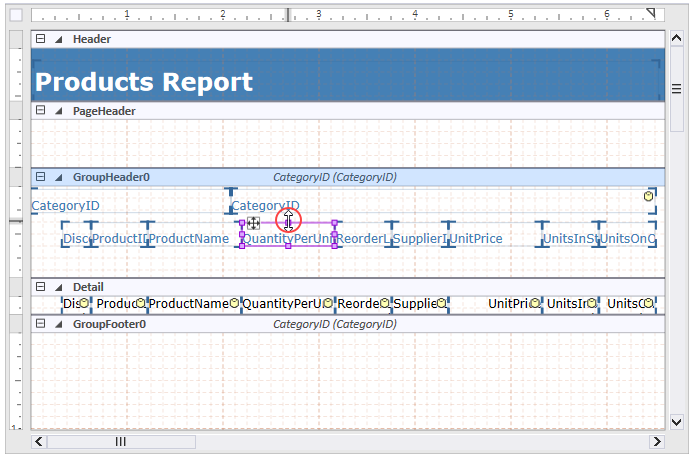
type=info
Tip: If the text is not fitting in the field, set the Appearance.WordWrap property for the field to True in the Properties window.
In the Properties window, select the UnitPriceLbl field in Detail section under the Unit Price column.
Set the Appearance.Format property for the field to Currency.
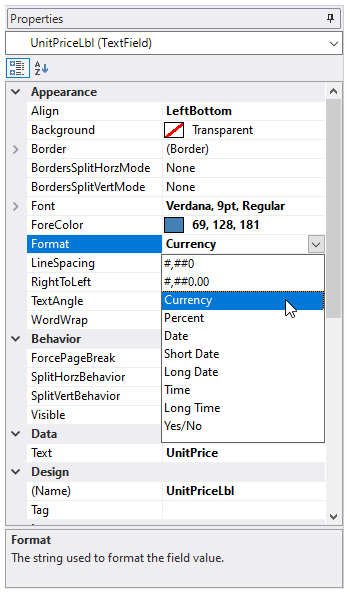
Click the Preview button to switch to Preview mode and see your modifications.
Click Design button to switch from Preview mode to Design mode.
Click the File menu and select Save As from the menu that appears.
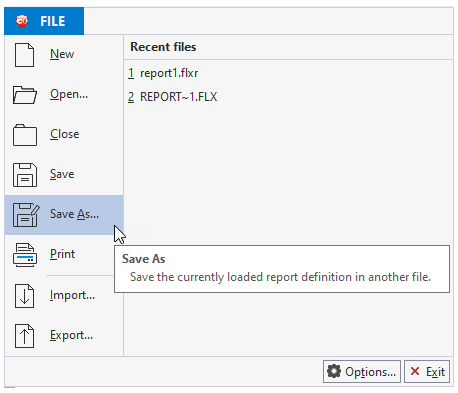
In the Save Report Definition File dialog box, enter ProductsReport.flxr in the File name box. Save the file to a location that you will remember for later use.
Close the Designer and return to your Visual Studio project.
You have successfully created a report definition file; in the next step you will load the report in the C1FlexReport component.
Load and render the report
To load a report definition from a file at design time, complete one of the following tasks:
Right-click the C1FlexReport component and select the Load Report menu option.
OR
Click the smart tag (
 ) above the C1FlexReport component and select Load Report from the C1FlexReport Tasks menu.
) above the C1FlexReport component and select Load Report from the C1FlexReport Tasks menu.
Using the Load Report dialog box, select the report you want and complete the following tasks:
- Click the ellipsis button. The Open dialog box appears.
- Browse to the location that you just saved your Products Report.flxr file, select it, and click Open.
- The available report definitions are listed in the Report drop-down box. Select the Products Report definition to load.
- Click Load and OK to close the dialog box.
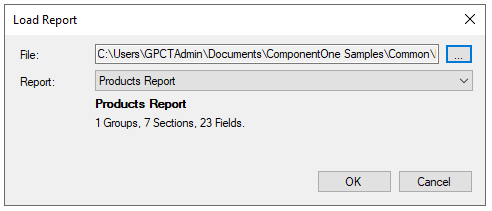
You can also load a report definition from a file via code. For this purpose, double-click the form and enter the following code in the Form1_Load event handler:
private void Form1_Load(object sender, EventArgs e)
{ // Creates a resource manager.
ComponentResourceManager resources = new ComponentResourceManager(typeof(Form1));
// Get the resource string that stores the report definition.
c1FlexReport1.ReportDefinition = resources.GetString("c1FlexReport1.ReportDefinition");
// Sets the report name.
c1FlexReport1.ReportName = "Products Report";
}
In the next step you will render the report into a preview control.
Once the report definition has been created, the data source defined and loaded into the FlexReport component, you can render the report to the printer to the preview control 'FlexViewer', or export to different file formats.
To preview the report in the FlexViewer control, the steps are as follows:
From the Toolbox, double-click the FlexViewer control to add it to your project.
From the Properties window, set the FlexViewer.Dock property to Fill.
Select the Windows Form with your mouse and drag the corners to resize it.
Double-click the form and enter the following code in the Form1_Load event handler:
private void Form1_Load(object sender, EventArgs e) { //load report definition c1FlexReport1.Load(@"..\..\Products Report.flxr", "Products Report"); //preview the report c1FlexViewer1.DocumentSource = c1FlexReport1; }Press F5 to run the code. Observe the output. It looks as shown below:
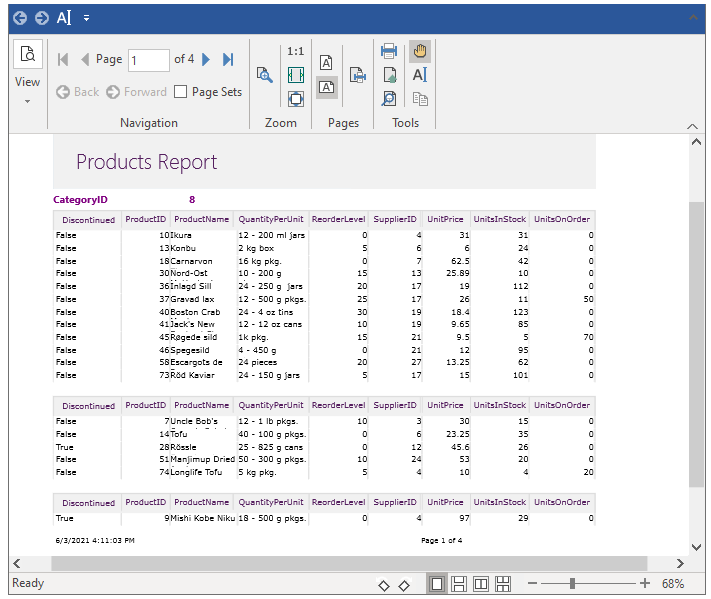
type=note
Note: WinForms .NET 6 Edition does not include rich design-time support yet. We will enhance it in the future releases.


